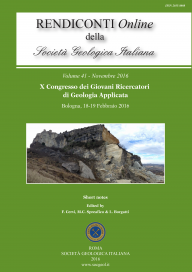
Soil properties and debris flows in Italy: potential relationships
Solange Scognamiglio (a*), Fabio Terribile (a,b), Michela Iamarino (a), Nadia Orefice (c) & Simona Vingiani (a,b)
(a) Department of Agricultural Sciences (DIA), University of Naples Federico II, Via Università, 100, 80055 Portici (NA) – Italy - E-mail: solange.scognamiglio@unina.it *Corresponding author: solange.scognamiglio@unina.it, DIA, Via Università, 100 – 80055 Portici (NA)- Italy; tel. +39 0812539180; fax +39 0812539186
(b) CRISP – Interdepartmental Research Center on the Earth Critical Zone, Via Università, 100, 80055 Portici (NA), Italy - University of Naples Federico II
(c) CNR-ISAFoM National Research Council, Via Patacca 85, 80056 Ercolano (NA), Italy
Volume: 41/2016
Pages: 199-202
Abstract
Debris flows are known to be very dangerous hazards that can produce fatalities and severe damages. In the Campania region they involve Andosols with a unique set of morphological, chemical, physical, and hydrological properties that give them high fertility but, at the same time, high fragility as concerns land degradation processes, such as erosion and landslides. Because of the shallow character of some debris flows (e.g. Campania), they can strongly involve and evolve in and over the soil cover. Therefore, a better understanding of the soil properties is crucial in an integrated approach finalized to evaluate the landslide susceptibility of mountain ecosystems. The aim of this work is to investigate the soil (chemical, physical, and hydrological) properties of the detachment areas of eight debris flows occurred in non-volcanic mountain ecosystems (NVME) of Italy in the last 70 years. In this framework, we will mainly focus on the assessment of the soil andic properties, in order to verify if in the studied landscapes the debris flows involve soils characterised by these properties, as it happens in the Campania region.
The analyzed events occurred on moderate to high slope gradient (ranging from 25° and 50°) and at different altitudes. Despite the lithological heterogeneity of the bedrock, the analyzed soils show remarkably similar features. Specifically, soils are generally deep and characterized by well developed topsoils, demonstrating that investigated sites were not subjected to intense erosion, which would have been expected considering the slope gradient. Moreover, these soils are markedly chemically and physically fertile, as indicated by the high organic carbon content and the prevalent loamy texture. As concerns the soil type, the preliminary analyses show that the investigated non-volcanic soils have andic and vitric features (except for Ceriana).
These findings shed new light on the similarity of the materials involved by debris flows both in volcanic and non-volcanic mountain ecosystems of Italy, suggesting a pedological control on the debris flow hazard.
Keywords
Get Full Text